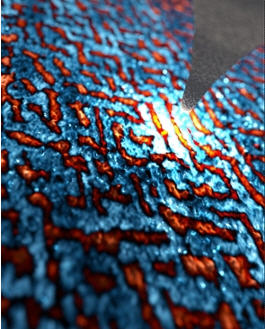Metal to insulator transition understood

Caption: Network of conducting and insulating rivers as seen in a metal-oxide in the middle of a phase transition (picture: A.S. Mueller).
Materials that conduct electricity at high temperature but are insulating at lower temperatures have been known for decades. However, until recently it was not possible to directly measure how such phase transitions proceed on small length scales. Using a new technique, Van Heumen and McLeod are now able to visualise the changes taking place in the material during such a phase transition on the nanometer scale.
In their experiments, the team observed a so-called percolation transition taking place among the electrons in the material. Above a certain critical temperature, the electrons can move relatively easily through the material enabling the flow of electrical current. When the temperature drops below a threshold temperature, small imperfections in the material trigger a kind of traffic jam for the electrons. Starting from small nanometer length scales, this traffic jam slowly grows outwards across the entire material. The previously freely moving electrons come to an abrupt halt and the material loses its conducting properties.
The material in which the team investigated the metal-to-insulator transition is the metal-oxide called vanadium-sesquioxide, V2O3, which is a more exotic relative of better known metal-oxides such as magnetite or rust. Such metal-oxides are interesting because of their exotic electrical properties, which could find use in future electronics applications.
`You could use these types of switchable materials alongside the current silicon technology used in cell phones or laptops’, says Van Heumen. ‘These materials are cheap, energy efficient and could contribute to improving sustainability.’ Van Heumen is also enthusiastic about possible applications on the interface with quantum technology.
`When used, silicon heats up and becomes disruptive to sensitive quantum technology. The abrupt metal-insulator transition that we investigated could also be forced to take place under influence of, for example, a light flash, which could find applications for better isolating the computational units of quantum computers.’
Nevertheless, more research on the phase transitions in oxides is needed before this becomes reality. Van Heumen: `The fundamental research we are currently doing to better understand the properties of these materials is similar in spirit to research on silicon forty years ago. Nowadays, silicon technology is integrated in all our electronics, so who knows what these materials will be used for twenty years from now.’
Using an ingenious method to increase the resolution of their microscope, Van Heumen and McLeod succeeded in testing a 60-year old theory that explains the switch from metal to insulator. Until recently, the wavelength of light – with a scale of several micrometers in the case of infrared light – limited the resolution of electrical conductivity measurements.
The physicists used a small needle to probe the insulating or conducting nature of the material below it with a resolution of 25 nanometers. The needle itself acts as a little antenna that sends this information back to a detector. McLeod: `Our technique allows optical imaging at unprecedented spatial resolution. With this unique method, we could directly visualise for the first time how the transition spreads through the material.’
The experiment took place at 100 degrees ℃ below freezing, not really ideal for real-world applications. However, Van Heumen believes that materials will soon be engineered to feature similar transitions at room temperature. `Making these materials is like Legos for experts. It is the focus of an intensive research effort that looks very promising.’
http://dx.doi.org/10.1038/nphys3882
For further information, please contact:
Johan Rheeder
+31 20 525 3591
Media Contact
More Information:
http://www.uva.nlAll latest news from the category: Physics and Astronomy
This area deals with the fundamental laws and building blocks of nature and how they interact, the properties and the behavior of matter, and research into space and time and their structures.
innovations-report provides in-depth reports and articles on subjects such as astrophysics, laser technologies, nuclear, quantum, particle and solid-state physics, nanotechnologies, planetary research and findings (Mars, Venus) and developments related to the Hubble Telescope.
Newest articles

NASA: Mystery of life’s handedness deepens
The mystery of why life uses molecules with specific orientations has deepened with a NASA-funded discovery that RNA — a key molecule thought to have potentially held the instructions for…

What are the effects of historic lithium mining on water quality?
Study reveals low levels of common contaminants but high levels of other elements in waters associated with an abandoned lithium mine. Lithium ore and mining waste from a historic lithium…

Quantum-inspired design boosts efficiency of heat-to-electricity conversion
Rice engineers take unconventional route to improving thermophotovoltaic systems. Researchers at Rice University have found a new way to improve a key element of thermophotovoltaic (TPV) systems, which convert heat…



